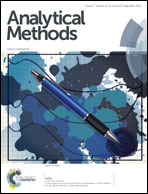Indium tin oxide coated PET film contactless conductivity detector for microchip capillary electrophoresis
Abstract
A conducting thin film contactless conductivity detection (CCD) sensor integrated with microchip capillary electrophoresis (CE) has been developed for the detection of metal ions. The CCD sensors were patterned on an indium tin oxide (ITO) coated poly(ethylene terephthalate) (PET) film using DuPont dry film as a negative photoresist, followed by the bonding of a poly(dimethylsiloxane) plate with the opposite side of the PET film. With the introduction of low-cost ITO-coated films and photosensitive films, the efficiency of prototyping and fabricating the desired microchip CE–CCD system was significantly enhanced. Relevant experimental parameters for using CCD to analyze metal ions were optimized, which include the concentration of the run buffer, gap between the two sensing electrodes, and excitation voltage and frequency. The analytical performance of the proposed device was illustrated by the separation of potassium, sodium, and lithium ions, which achieved the detection limits of 5.8 μM, 8.0 μM, and 14.3 μM, respectively. Furthermore, the versatility of the device was demonstrated by the determination of a simulation sample with a mixture of heavy metal ions, which included zinc, cadmium, and copper ions in Xiangjiang River water. The three weak base ions were completely separated within 1 min with negative peaks because they bind with acetate ions.


 Please wait while we load your content...
Please wait while we load your content...